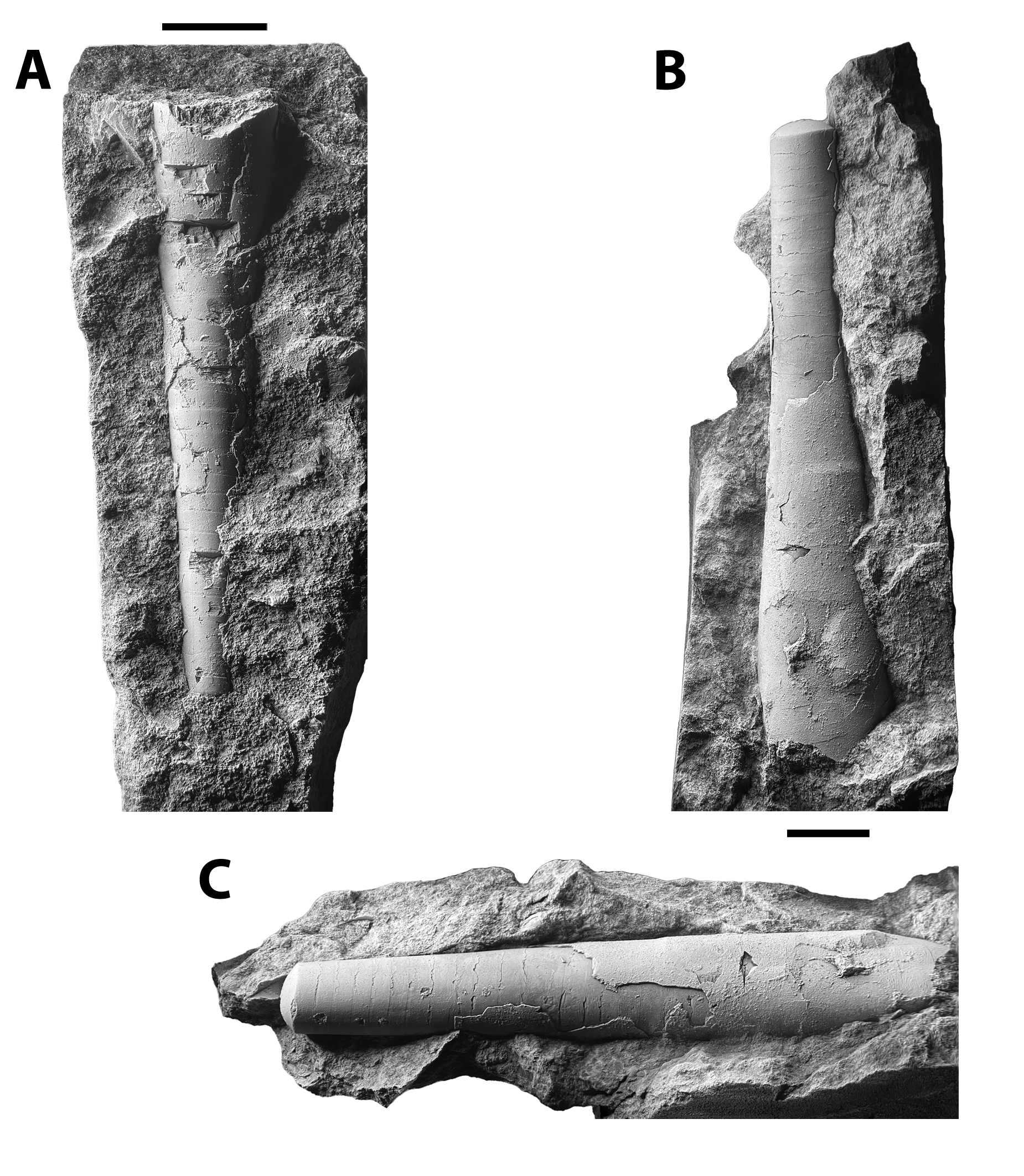Order Pseudorthocerida Barskov, 1963
Family Pseudorthoceratidae Flower and Caster, 1935
Genus Pseudorthoceras Girty, 1911
Species knoxense Sturgeon, 1982
Girty erected Pseudorthoceras from specimens of the now Middle Ordovician Orthoceras. It is the most common species of cephalopod from the Pennsylvanian period. Kröger and Mapes (2005) called it the “characteristic orthocerid of the Carboniferous in general”. The local distribution follows Metacoceras; it is not clear which of the two is the most common in the two limestones in Armstrong County that are the subject of investigation for this book.
Another orthocerid genus, Mooreoceras, is similar except for size, siphuncle position, and a slightly depressed whorl section. There has been much debate around a link between Pseudorthoceras and Mooreoceras. No known apical (pointed side) portions of Mooreoceras exist, begging researchers to question if Pseudorthoceras specimens are simply the apical ends of Mooreoceras. One significant problem is the siphuncle position, which is eccentric in Mooreoceras, but in Pseudorthoceras, it is in the center.
Kröger and Mapes (2005) thoroughly investigated the two genera. The pair measured the ratio of the two principal axes of the ellipse of the cross-section, septal spacing, siphuncle position, and the expansion rate over 196 species across both genera. For example, the septal spacing for any two specimens in the same or different genera is inconsistent. They could find no compelling evidence that anyone would split the two based on anything but their size. The result was a rendering of Mooreoceras as invalid.
The subclass Orthoceratoidea M’Coy 1844 went extinct at the end of the Triassic, so studying how these cephalopods lived is limited to interpreting the fossil record. Some believe that the order Orthocerida went extinct at the end of the Triassic, but others feel that these late examples may represent Pseudorthocerids.

References
- Kummel, B., 1964. Nautiloidea-Nautilida, p. K383–K466. In R. C. Moore (ed.). Treatise on Invertebrate Paleontology, Part K, Mollusca 3. Geol. Soc. Am. and Univ. Kans. Press, Lawrence.
- Miller, Unklesbay, 1942. The Cephalopod Fauna of the Conemaugh series in Western Pennsylvania, Annals of the Carnegie Museum
- Miller, A.K., Unklesbay, A.G., 1947. The Cephalopod Fauna of the Conemaugh Series in Western Pennsylvania: Supplement, Annals of the Carnegie Museum, v. 30, pp. 319–330
- Sturgeon, M. T., Windle, D. L., Mapes, R. H., Hoare, R. D., 1982. New and Revised Taxa of Pennsylvanian Cephalopods in Ohio and West Virginia, Journal of Paleontology, Vol 56, No. 6, November 1982. pp. 1453–1479
- Sturgeon M.T. et al, 1997. Pennsylvanian Cephalopods of Ohio, Part 1 Nautiloid and Bactritoid Cehphalopods, pp. 26–28, pp. 98–99

Late Carboniferous Fossils from the Glenshaw Formation in Armstrong County, Pennsylvania
Preface | The Photographic Process
Localities: Locality SL 6445 Brush Creek limestone | Locality SL 6533 Pine Creek limestone
Bivalvia: Allopinna | Parallelodon | Septimyalina
Cephalopoda: Metacoceras | Poterioceras | Pseudorthoceras | Solenochilus
Gastropoda: Amphiscapha | Bellerophon | Cymatospira | Euphemites | Glabrocingulum | Meekospira | Orthonychia | Patellilabia | Pharkidonotus | Retispira | Shansiella | Strobeus | Trepospira | Worthenia
Brachiopoda: Cancrinella | Composita | Isogramma | Linoproductus | Neospirifer | Parajuresania | Pulchratia
